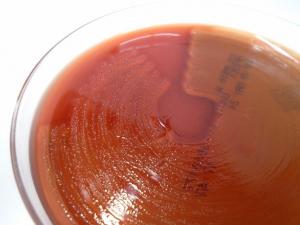AHL Labnote 67-Diagnosis of strangles
Tim Pasma
Strangles, caused by Streptococcus equi subspecies equi (Streptococcus equi), is a bacterial disease that affects horses, donkeys, mules and zebras. There are two main tests available at AHL for diagnosis of strangles: PCR and culture.
The S. equi PCR is a rapid test that is 3 times more sensitive than bacterial culture. As it can detect small numbers of bacteria, it is particularly useful for detection of S. equi carrier horses. However, PCR does not differentiate between live and dead bacteria; therefore, a positive test result may not indicate an active infection.
A bacterial culture is less sensitive than the PCR and has a longer turn-around time, as it requires time for the bacteria to grow. It can miss horses that are in the early stages of infection or carrying a low load of bacteria. However, a culture is required to conduct antimicrobial sensitivity testing.
Which test to use will also depend on the stage of infection. Sampling too early in the infection (within 48 hours of the onset of fever) may result in negative test results and repeated sampling may be needed to make a diagnosis. In general, at the early stages of infection, bacterial culture is negative but PCR can be positive when a nasopharyngeal sample is used.
Sample site and sampling technique should also be taken into consideration in S. equi detection. The nasopharynx will have bacteria in the early stages of the infection while the guttural pouch will harbour the bacteria for months to years. Lavage of the nasopharynx and guttural pouch will sample more area, and is more sensitive compared to a swab. The use of an endoscope will assist with collection of the sample and visualization of affected passages.
Occasionally, positive PCR tests may occur in horses without clinical signs or that are negative on bacterial culture. Reasons for this include:
- the horse was exposed to a low dose of the bacteria
- the horse may be a carrier of the bacteria that is below the threshold to cause disease
- the horse may be in an early stage of infection
- clinical signs (e.g., fever) may have been missed in the early stages of the disease
- the endoscope may be contaminated from a previously tested horse or the sample may have picked up environmental contamination
- the horse may have been previously vaccinated within the past 6 weeks with an attenuated live vaccine strain. PCR sequence typing will differentiate between vaccine and field strains, and is available at the AHL for a strong positive PCR result (Ct < 30) and pure bacterial culture results.
Recommendations for S. equi testing include:
- take samples for culture (viability) and PCR (sensitivity)
- test at weekly intervals if you suspect a horse has been exposed or is infected
- submit samples from as many animals as possible if multiple animals are affected
- nasopharyngeal lavage is best for detecting infections in the early stage (swabs can also be used, but lavage is preferred)
- guttural pouch lavage by endoscope is best for detecting carriers
- lavage of both the nasopharynx and guttural pouch provides the most sensitive test result
- ensure that the endoscope is thoroughly cleaned and disinfected between uses
 |
| Figure 1. Strep. equi ssp. equi on a blood agar plates |
While culture detects viable S. equi, PCR will detect DNA from viable or non-viable bacteria. A recent study found that a qPCR Ct of 34.2 was a reasonable breakpoint for the likelihood of the presence of culturable S. equi (Weese et al, 2023).
If you obtain a Strep. equi test result that is not expected based upon clinical findings and history, please contact the AHL to review the result and discuss follow-up options.
Reference
Weese JS, Saab M, Moore A, Cai H, McClure JT. Relationship between quantitative real-time PCR cycle threshold and culture for detection of Streptococcus equi subspecies equi. Canadian Veterinary Journal 2023;64:549-552.
Dr. Tim Pasma Client Services Veterinarian
519-824-4120 ext 54611




